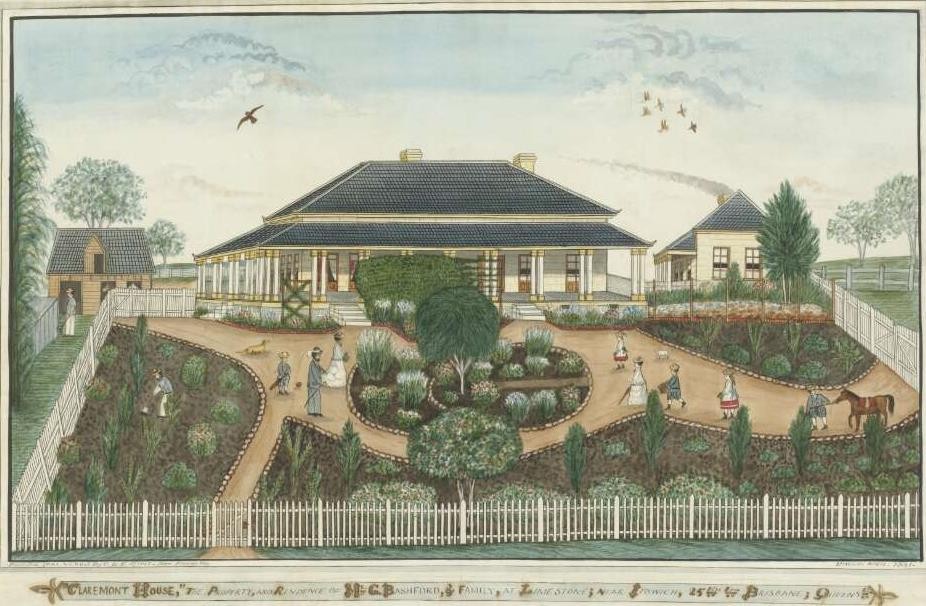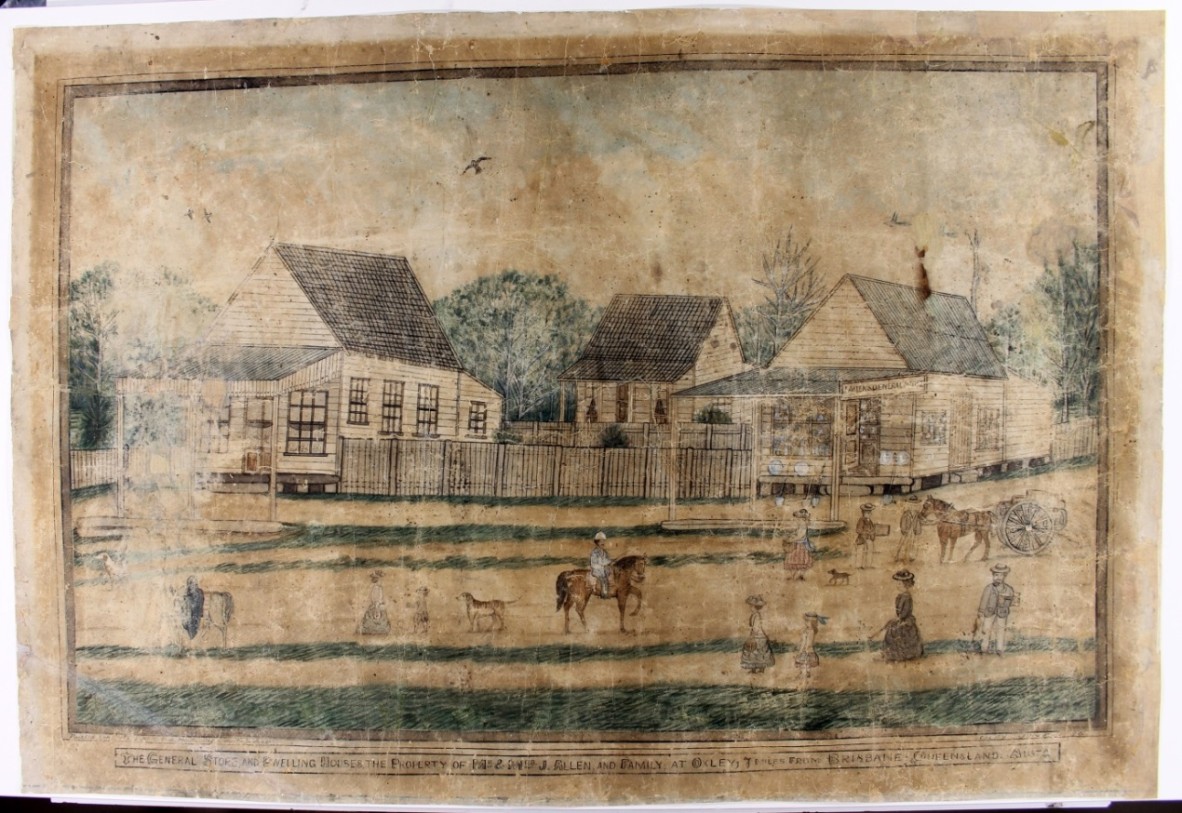Charles Gordon Sebastian Hirst 1826-1890: “an itinerant artist about whom little is known”
By JOL Admin | 21 December 2015
“An itinerant artist about whom little is known” is the usual description of Charles Gordon Sebastian Hirst, the artist who did naïve depictions of northern New South Wales and Queensland properties.

C G S Hirst (1881). Claremont House, the residence of Mr George Bashford, near Ipswich.
Retrieved 15 December 2015 from http://nla.gov.au/nla.obj-135226086
However, State Library of Queensland’s paper conservator, Gajendra Rawat, in restoring Hirst’s work, wondered what background Hirst brought to his paintings. A breakthrough came in realising that Hirst had been at the Dunwich Benevolent Asylum. An entry form would contain valuable personal details. The response to an enquiry to Queensland State Archives produced the following information:
- Hirst was born in London and aged 60 in May 1885
- His parents were Henry John Hirst and Frances Eliza Jackson
- He claimed to be an architect and surveyor
- He neither married nor had children
- He came to Brisbane on the ship Maryborough in 1870
- He had a claim on a property in Rotherham, Yorkshire
Charles Hirst’s family
The records of St George the Martyr, Southwark, London showed a Charles Hirst born on 2 July 1826, along with a twin, George, who died in infancy. His parents were Henry John Hirst (formerly Shirt) and Frances Eliza Jackson French.
His background was wealthy and privileged. Henry John Shirt, Charles’s father, was born in London to Samuel and Sarah Shirt on 15 April 1799. He was heir to his mother’s first cousin, John Hirst, who died without descendants in 1804. In 1820 Henry John was granted the arms of Hirst in accordance with the will, which included his change of surname. As a result, he inherited many Yorkshire properties.
Frances Eliza Jackson (French) was born on St Vincent in the West Indies around 1806, according to census information and her death record. She was the daughter and co-heiress of Lieut-Col Sebastian French, and married Henry John Hirst on 1 August 1822 at the church of St George the Martyr, Southwark. Their first son, Henry Robert, was born on 3 August 1822. Another son, Edward Sebastian Gordon, was born in 1823 (he died unmarried in 1849). The extensive charts in Joseph Foster’s Pedigrees of the County Families of Yorkshire Vol II West Riding (1874) detail the family’s connections. They also state that Charles was alive and unmarried at the time.


Pedigrees of the County Families of Yorkshire Vol II West Riding (1874) compiled by Joseph Foster. Images from www.archive.org
In the 1841 census, Henry John Hirst was listed at Lambeth, of independent means, with his wife and three of his children, including Charles, then 14. In the 1851 census, Henry John Hirst was in the Queen’s Prison, Southwark.
Contemporary newspapers record his financial activity. The Leeds Mercury of 20 October 1821 advertised a valuable coal seam at Clough near Rotherham to let. The Yorkshire Gazette of 31 May 1845 listed property from the Yorkshire Estates to be auctioned. The Bradford Observer of 8 June 1854 stated that Henry John Hirst, a prisoner in the Queen’s Prison, Surrey, was linked to railway dealings, that he was being sued and would be dealt with on 26 June.
In the 1851 and 1861 censuses, Henry John Hirst’s wife was living with other family members. Neither Charles nor his father was with them. In the London Times of 4 May 1864, a 20 shillings reward was offered to parish clerks and others “providing evidence of the death or evidence of the present residence of Henry John Hirst”. The death of Henry Robert, Charles’ eldest brother and Henry John Hirst’s heir, was announced in the Yorkshire Post and Leeds Intelligencer on 3 April 1872. In September 1872 Charles’s father, Henry John, died. Charles was the oldest surviving male of his family as shown in Foster’s Pedigrees. Charles’s mother died in 1880. Possibly he should have been reasonably well off from inheritances from both parents, or perhaps embarrassed by his father’s dealings.
What was happening to Charles Hirst?
Only his brief references track his education and movements from 1841 to 1870. English records of Liverpool ships’ crew show his arrival in Queensland on the Maryborough as an assistant baker with an additional given name, Gordon. His previous ship had been the Barham, which made trips to India. In 1880 he was admitted to Dunwich Asylum as Charles Gordon Sebastian Hirst (two additional names, Gordon Sebastian, from his mother’s family), ostensibly for suffering a loss of sight.
What preceded his Dunwich admission?
During the 1870s and 1880s, for about a year and a half, Hirst painted pictures of houses and scenes principally in Queensland, but also in New South Wales.
On 25 November 1874, in a letter to the Brisbane Courier about the transit of Venus, he refers to “a long and nomadic career in the Far East, from a very early age”. He “kept records, and communicated data on nearly every scientific event to the various Indian papers”. He applied unsuccessfully to design the Mooney Fountain in Brisbane and, in the Telegraph in 1880, complained of the illegibility of the monument’s script. He added that he had “a smattering of Greek, Roman and Sanskrit" and referred to "municipal snobberies ‘at home’ and in the East”, which, he said, “this writing style exceeded”.
A trail of woes
The Brisbane Courier of 17 January 1880 received his letter “written apparently in a state of despondency verging on despair” saying his “life ruined forever” by the theft of “160 water-color drawings of colonial scenery”, which were designed for an exhibition in England, “illustrative of colonial life”. Hirst unsuccessfully urged the newspaper to “raise subscriptions to furnish the materials for a new collection of similar drawings", saying his “misfortune is a national loss”.
During the trial of the accused thief, Alessio, the Queenslander of 24 April 1880 reported that Joseph A Clarke, an artist residing in South Brisbane, “stated that he had had a good many years' experience in art work, more especially in water-color and oil paintings, and was acquainted with the value of such drawings in this colony; the pictures produced in court had no value as works of art, but might be purchased by persons interested in the scenes depicted.”

The General Store and Property of the Allen Family at Oxley 1886 restored. State Library of Queensland.
Charles Hirst’s Dunwich form showed re-admissions in 1885 to March 1890. In Queensland Figaro and Punch of 12 January 1889, he thanked benefactors to the asylum as “the bulk of the inmates that live in this asylum cannot be further down (without crime) than they are by poverty, old age, blindness and disease.”
Finally, the Brisbane Courier announced on 8 March 1890 that Hirst “was taken to the hospital … suffering from an overdose of laudanum”. He died at the Plough Inn, South Brisbane, his parents unrecorded on his death certificate.
Hirst remains an enigma. Many judge his training as a surveyor and architect unlikely, based on his artwork. The Madras Institute, of which he claimed membership, is elusive. Is it the Madras College, founded by Andrew Bell, who educated the children of soldiers by using masters to teach older students, who then taught younger students? What did he do in India? Was he the Charles Hirst he claimed to be, even though his personal details align with the records? There were several people in India named Hirst. Knowledge of his missing years (1842-1870) could illuminate the background of this “itinerant artist”. Any additional information would be greatly appreciated.
Gajendra Rawat, Paper Conservator, State Library of QueenslandStephanie Ryan, Senior Librarian Information Services, State Library of Queensland
Thanks to Allison Drechshage, Senior Reference Archivist, Queensland State Archives
Comments
Your email address will not be published.
We welcome relevant, respectful comments.